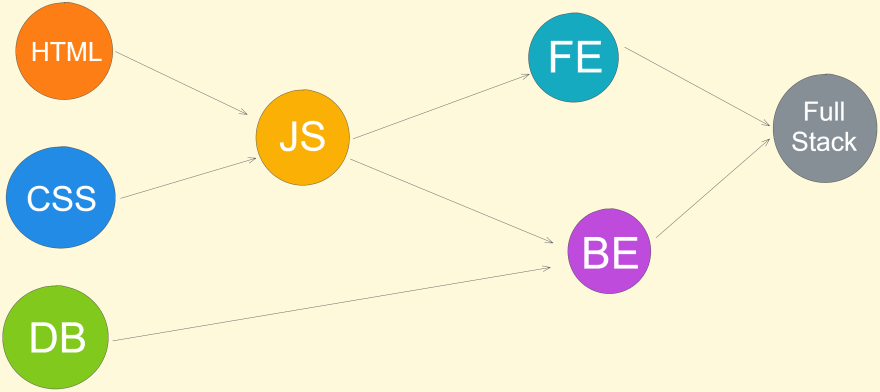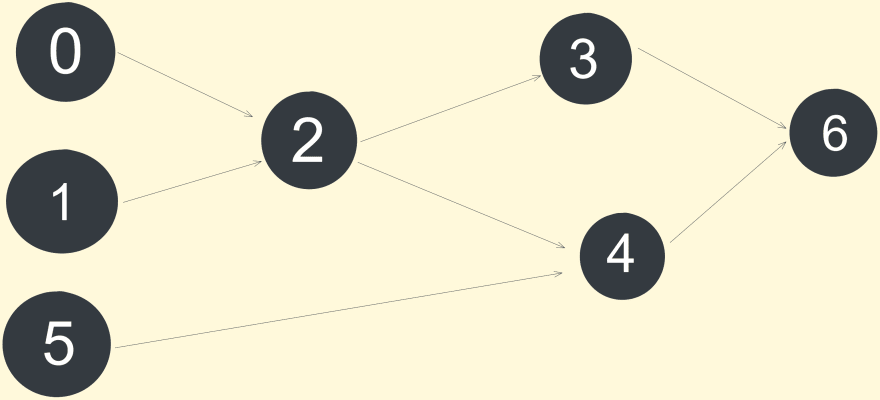An Interest In:
Web News this Week
- April 19, 2024
- April 18, 2024
- April 17, 2024
- April 16, 2024
- April 15, 2024
- April 14, 2024
- April 13, 2024
Topological sort, Solving Google Interview Question
If we want to become a full-stack developer we follow the following path :
First, we learn basic HTML & CSS, then we learn Javascript. Then the path diverges into FrontEnd development and BackEnd development, for becoming a backend developer we need to study a database and finally we become a full stack developer.
So this path is fixed, to learn a frontend framework, you need to know the basics of HTML, CSS, and JavaScript.
There is a one-directional relationship between components, we can't first learn React and then learn HTML.
Topolocial Sort is the ordering in which things should happen/occur, there are many real-life use like when processing large data, data is supplied in chucks so that the resource utilization is optimal and then the processed data is transferred. Largest friendship distance in the network also known as six degrees of separation on a social media network is solve using Topological Sort.
Now that we know what's topological sort and it's uses, let's solve a question asked frequently at Google.
X-------------------------------------------------------------X
Question: Course Scheduler
There are a total of n courses you have to take, labeled from 0 to n-1.
Some courses may have prerequisites, for example, to take course 0 you have to first take course 1, which is expressed as a pair: [0,1]
Given the total number of courses and a list of prerequisite pairs, return the ordering of courses you should take to finish all courses.
Given input is numCourses for the number of courses to take, prerequisites array which determines the dependency between courses. If it's not possible then return 0.
For eg : if give data is [[2,0],[1,0],[3,2],[4,2],[5,4],[6,3],[6,4]]
From this we can say a possible order could be : [0,1,5,2,3,4,6]
Step 1: Building the graph
Graphs are represented as adjacency list/adjacency matrix. Both are easy to implement. In this case, we shall use the adjacency list since the graph is a sparse graph (ie many nodes aren't connected to each other).
Along with our graph, we shall maintain an array, indegree which will maintain the count of prerequisites for node "i"
var topologyOrder = function(numCourses,prerequisites){ // create each individual node let graph = new Array(numCourses); // to track the number of dependencies required by each node let indegree = new Array(numCourses); for(let i=0;i<numCourses;i++){ graph[i] = []; } for(let prerequisite of prerequisites){ let from = prerequisite[1]; let to = prerequisite[0]; graph[from].add(to); indegree[to]++; }}By end of this operation our graph will look like :
graph = [[2] // 0 -> 2 [2] // 1 -> 2 [3,4] // 2 -> 3, 2 -> 4 [6] // 3 -> 6 [6] // 4 -> 6 [4]] // 5 -> 4 indegree = [ 0, // 0 ie no prerequisites 0, 2, // 2 courses are required before this 1, // 1 course is required 2, 0, 2 ]Now that we have a graph, information about how many courses needs to be finished before taking a certain course. Let's move ahead to the next step.
Breadth First Travesal
First step will be to take classes which have indegree of "0" ie no prerequisites.
Also, we maintain a queue to process each node in graph as we always do in a BFS traversal.
let queue = []; for(int i=0;i<indegree.length;i++){ if(indegree[i] == 0){ queue.push(i); } }Our next step will be to process each node in queue, but before that, we need to ensure that there are nodes to be processed in the queue.
Eg: if given input is [[0,1],[1,0]], ie 0 -> 1 and 1 -> 0. We're in a deadlock.
if(queue.length == 0) return 0;Our next question is how to process the nodes? And at the same time, we have to ensure that there's a unidirectional flow and a node isn't visited again because then we end up in an infinite loop.
So we create an array and a set and a counter :
let res = []; // to store the result let visited = new Set(); // to store visited nodes let count = 0; // safety check to ensure all nodes are visitedNext steps are :
Step 1> Go through the queue,
Step 2> Pop a node
Step 3> Process that node by setting it as visited and adding it to result
Step 4> visit all the child nodes of current node and decrease their indegree by 1
Step 5> Increment the count
Step 6> repeat steps 1 - 5 till queue is empty.
while(queue.length>0){ // pop a node from queue let node = queue.shift(); // check if it's visited, if it's the return 0 if(visited.has(node)) return 0; // add node to visited set visited.push(node); // add node to result res.push(node); //loop over all the nodes require current node as a prerequisite for(int n of graph[node]){ // since current node is processed, decrease the indegree of node "n" by 1 indegree[n]--; // if node "n" indegree equals 0, add it to the queue so that it can be processed if(indegree[n] == 0) queue.push(n); } // incremenet count by 1 count++;}Let's see the above steps in animation. If possible open the gif in another tab and compare each step with the above code.
putting it all together :
var topologyOrder = function(numCourses,prerequisites){ let graph = new Array(numCourses); let indegree = new Array(numCourses); for(let i=0;i<numCourses;i++){ graph[i] = []; } for(let prerequisite of prerequisites){ let from = prerequisite[1]; let to = prerequisite[0]; graph[from].add(to); indegree[to]++; } let queue = []; for(int i=0;i<indegree.length;i++){ if(indegree[i] == 0){ queue.push(i); } } if(queue.length == 0) return 0; let res = []; let visited = new Set(); let count = 0; while(queue.length>0){ let node = queue.shift(); if(visited.has(node)) return 0; visited.push(node); res.push(node); for(int n of graph[node]){ indegree[n]--; if(indegree[n] == 0) queue.push(n); } count++; } return count == numCourses ? res : 0;}Thanks a lot if you made it till here :) I hope you liked my article.
If I messed up somewhere or didn't explain clearly, do comment.
github : https://github.com/AKHILP96/Data-Structures-and-Algorithms/blob/master/Algorithm/TopologicalSort.js
Original Link: https://dev.to/akhilpokle/topological-sort-solving-google-interview-question-cb
Dev To
 An online community for sharing and discovering great ideas, having debates, and making friends
An online community for sharing and discovering great ideas, having debates, and making friendsMore About this Source Visit Dev To




